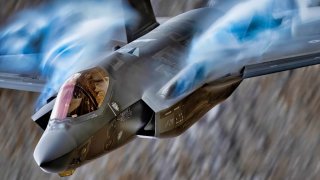Hot Pit: How F-22 Raptors and F-35 are Training in China's Backyard
The U.S. Air Force's F-22 Raptors and the Royal Australian Air Force's F-35A Lightning IIs recently trained together in Agile Combat Employment (ACE) operations, a crucial skill set for potential conflict with China. They are sometimes referred to as hot pit drills.
Summary and Top Points: The U.S. Air Force's F-22 Raptors and the Royal Australian Air Force's F-35A Lightning IIs recently trained together in Agile Combat Employment (ACE) operations, a crucial skill set for potential conflict with China. They are sometimes referred to as hot pit drills.
Why It Matters: These exercises, held at a remote base in Western Australia, focused on expediting refueling to sustain combat power without the need for air tankers. The training demonstrated the ability of U.S. and Australian forces to integrate and rapidly deploy air power in challenging locations.
Bottomline: With Australia acquiring 100 F-35s, this partnership enhances the collective deterrence against regional threats, particularly from China.
Recently, the American F-22 Raptor and Australian F-35A Lightning II stealth fighter jets trained on one of the most important skill sets in the event of a possible conflict with China.
The Agile Combat Employment (ACE) concept is designed to sustain combat power in the skies by expediting refueling.
ACE Ops for F-22 and F-35
U.S. Air Force (USAF) F-22 Raptors from the 27th Expeditionary Fighter Squadron and their counterparts, the Royal Australian Air Force (RAAF) F-35A Lightning IIs from the 75th Squadron conducted hot pit refuels. Essentially, Formula 1 pit stops, but for combat aircraft. ACE ops train pilots and maintainers to put aircraft on the sky as quickly as possible in the absence of air tankers.
“We demonstrated the ability for USAF and RAAF to integrate F-22s with F-35s and deploy outback to a bare base in western Australia,” Faux, an F-22 Raptor pilot with the 90th Fighter Squadron, said.
The U.S. Air Force already operates both the F-35 Lightning II and the F-22 Raptor, so it is well-established that the two stealth fighter jets can operate together seamlessly.
“This mission was a proof of concept of our ability to fly, fight, and win any time, any place, anywhere with our Allies and partners. RAAF Curtin is a strategic location in ensuring maximum flexibility and the security of a free and open Indo-Pacific,” the American pilot, who was identified by pseudonym for operational security purposes, added.
“We’re willing to take risks if it means better agility and combat capability. The execution of this went very smoothly, the RAAF seems to operate on the same wavelength as us,” Master Sgt. Luke Ashman, the aircraft section chief of the 27th Expeditionary Fighter Generation Squadron, stated.
The F-22 Raptor is the first stealth fighter jet. In operation only by the U.S. Air Force, the F-22 is the best air superiority fighter jet in the world. On the other hand, the F-35 Lightning II is the best multirole fighter jet in the skies, and it is set to be operated by nineteen countries; the U.S. military alone has ordered almost 2,500 aircraft.
“It is always a challenge going into locations that are not fully developed bases. Our goal in going was to continue to develop techniques and procedures for non-standard operating locations and prove that we can rapidly and effectively deploy air power to any location, no matter how remote. By bringing our support personnel and jets from both the USAF and RAAF, we were able to gather invaluable data points for utilizing this base for agile employment in the future,” Faux added.
The Royal Australian Air Force has ordered 100 F-35A Lightning II stealth fighter jets. Once the order is fulfilled, they will possess one of the strongest and most advanced air forces in the region. Alone, the Royal Australian Air Force wouldn’t be able to deal with the Chinese air force, which numbers in the thousands of aircraft. However, the Australian fighter jets will add to the unified deterrence of the United States and its other partners in the region. That is why such training events like the one taking place in Australia are so important.
About the Author:
Stavros Atlamazoglou is a seasoned defense journalist specializing in special operations and a Hellenic Army veteran (national service with the 575th Marine Battalion and Army HQ). He holds a BA from Johns Hopkins University and an MA from the Johns Hopkins School of Advanced International Studies (SAIS). His work has been featured in Business Insider, Sandboxx, and SOFREP.
Image Credit: Creative Commons and/or Shutterstock.


